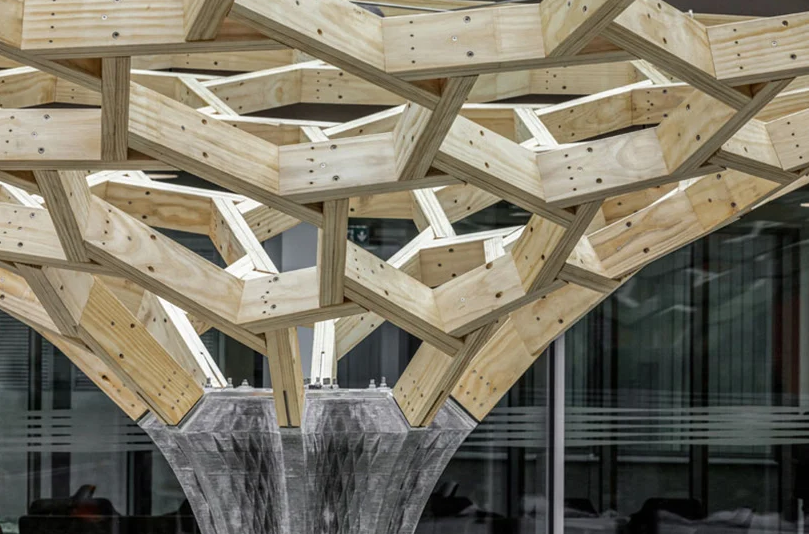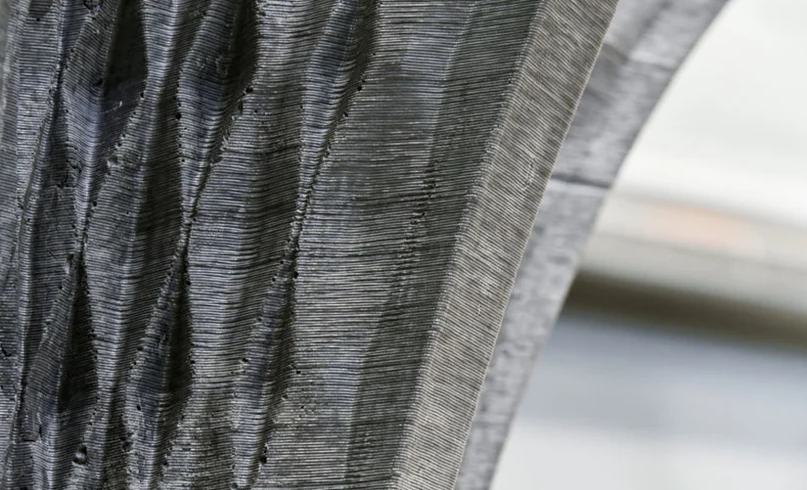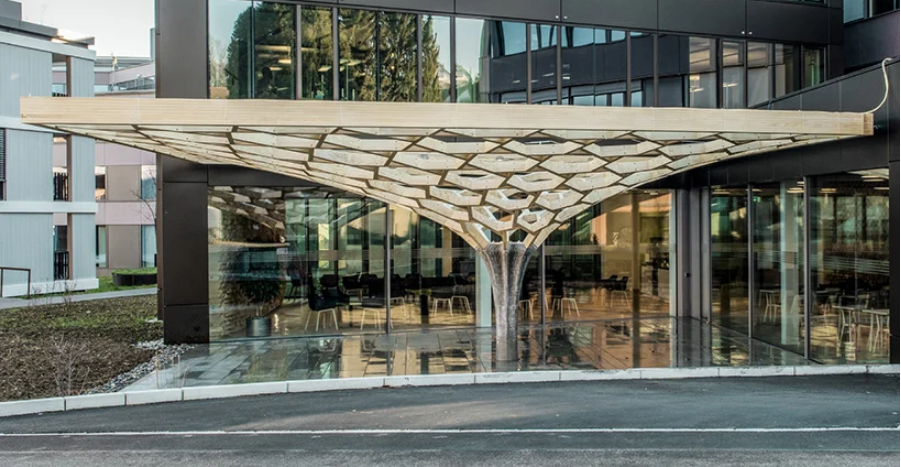A wide range of fascinating projects continue to emerge from leading university, ETH Zurich, a source of prolific research in science and exploration of technology like 3D and 4D printing. Scientists there have offered a continued and insightful focus into architecture, construction, and the progressive use of materials like cement and even sand and metal. ETH Zurich’s forays into complex design and digital construction techniques have been well-noted, along with a recent project outlining the development of an eggshell method used to 3D print ultra-thin frameworks.
Now, recent news highlights the “planting” of the Future Tree pavilion, serving as a further result of the study and published paper, “Eggshell: Ultra-Thin Three-Dimensional Printed Formwork for Concrete Structures.” This graceful piece of architecture, standing at nearly seven feet tall, combines all the strengths of previous ETH Zurich work, demonstrating their knowledge of design and materials with robotics and 3D printing. Completed by gramazio kohler research in connection with the university, the tree overlooks the courtyard of a Swiss AEC consultancy company, Basler & Hofmann.
The Basler and Hofmann design team collaborated on the pilot project, describing it as their pilot project for parametric planning:
“The future tree’s stem is a reinforced concrete column, made using an ultra-thin formwork, 3D printed by a robot, and filled with a custom-developed fast-hardening concrete,’ said the design team. “This novel fabrication process, known as ‘eggshell,’ allows for the fabrication of non-standard, structurally optimized concrete structures, whilst being able to integrate standard reinforcement and minimize formwork waste. The eggshell process makes use of fused deposition modeling (FDM) 3D printing in order to achieve a wide design and fabrication space.”
The formidable formwork was 3D printed in one piece via a large-scale printer outfitted with a six-axis robotic arm featuring a build volume of 1.2 × 1.2 × 3.6 m. Extruding occurred through the end of the arm, using a 1.5 mm nozzle, and standard filament. Issues such as shrinkage presented challenges to the designers, who solved the problem by using a diamond-shaped micro-pattern on the formwork, decreasing stress, and providing better stiffness in the material. One of the greatest advantages in eggshell printing is the ability to use formworks as thin as 1.5 mm with the smart dynamic casting (SDC) method created by ETH Zurich.
“In this way pressure on the formwork is reduced to a minimum and an 8 kg formwork could be used to fabricate a column of 800 kg,” said the design team.

With sunny weather, the reciprocal frame casts a pattern of shadows on the ground (Image courtesy of © gramazio kohler research, ETH Zurich)
Covering 1,152 square feet, or over 107 square meters, the canopy is comprised of 380 acetylated timber elements joined with screws. Attached to the building on two sides, it sits on the concrete column.
“Here, motivated by the frame’s structural behavior, the honeycomb pattern gradually transforms between a hexagonal and a triangular in order to achieve varying levels of flexural rigidity in different areas of the frame,” said the designers.
“The increasingly triangular configuration in the cantilevering corner makes this area stiffer and locally minimizes structural deformations.”

Close-up of the column crown at the interface with the wooden structure (Image courtesy of © Basler & Hofmann AG)
This complex design is the result of a complex computational model that led the designers to the ultimate geometry, as well as assessment, of the tree. The structure was described with an algorithm, allowing for programming that ensured stability—and feasibility—in the architecture. Find out more about research into eggshell printing.

The diamond texture of the column helped to stabilize the print during printing and casting (Image courtesy of © gramazio kohler research, ETH Zurich)
Subscribe to Our Email Newsletter
Stay up-to-date on all the latest news from the 3D printing industry and receive information and offers from third party vendors.
Print Services
Upload your 3D Models and get them printed quickly and efficiently.
You May Also Like
3D Printing News Briefs, June 11, 2025: Sustainability, Automotive Tooling, & More
We’re starting with sustainability news in today’s 3D Printing News Briefs, as EOS has strengthened its commitment on climate responsibility, and Zestep is making 3D printing filament out of eyewear...
3D Printing 50 Polymer Stand-In Parts for Tokamaks at the PPPL & Elytt Energy
Of all the world’s things, a tokamak is one of the hardest, most complex, expensive and exacting ones to make. These fusion energy devices make plasma, and use magnets to...
3D Printing News Briefs, May 17, 2025: Color-Changing Materials, Humanoid Robot, & More
We’re covering research innovations in today’s 3D Printing News Briefs! First, Penn Engineering developed 3D printed materials that change color under stress, and UC Berkeley researchers created an open source,...
Firehawk Aerospace Partners with JuggerBot 3D, Gets $1.25M from AFWERX for 3D Printed Propellants
Texas-based Firehawk Aerospace, an advanced energetic materials firm that works with aerospace and defense applications, announced a strategic partnership with JuggerBot 3D, an Ohio-based large-format 3D printer manufacturer. Together, the...


































